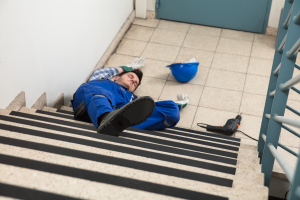In this article, we will discuss when you may be eligible to claim compensation for an injury that you sustained due to broken steps at work. Whilst at work, your employer owes you a duty of care. The information provided in this guide will cover how your employer could breach this duty of care, and when this could lead to you sustaining injuries. We will also discuss the time limits that you must consider when making a personal injury claim against your workplace, and the evidence that you could provide to support your case.

Broken Steps At Work Compensation Claims Guide
Additionally, this article discusses how compensation payouts could be calculated for successful accident at work claims. Finally, we will also explore how choosing to use a No Win No Fee solicitor could allow you to access the services of a legal professional without being charged upfront or ongoing fees for these services.
To find out more, read on. You can also contact our team of advisers to ask any questions you may have about bringing forward a personal injury claim following an accident at work. For instance, they may provide you with a personalised estimate of the compensation that you could be eligible to receive. To make an enquiry and receive a free consultation, you can:
- Contact us using our online form
- Call us at 0800 073 0081
- Speak to our advisers using the live chat window below
Select A Section
- Could I Claim If I Was Injured Due To Broken Steps At Work?
- How Could You Be Injured By Broken Steps At Work?
- How To Prove Broken Work Steps Caused Your Injuries
- What Could I Claim For An Accident On Broken Steps At Work?
- Making A No Win No Fee Work-Related Injury Claim
- Learn More About Accidents Caused By Broken Steps At Work
Could I Claim If I Was Injured Due To Broken Steps At Work?
If you’ve sustained injuries in an accident at work, for which your employer was liable, you may be eligible to bring forward a compensation claim. It is important that you are able to provide evidence showing that your employer breached the duty of care outlined in the Health and Safety at Work etc. Act 1974 (HASAWA). This piece of legislation states that employers must take all reasonably practicable steps to ensure the health, safety and welfare of their employees at work.
For example, this can include the following:
- Performing risk assessments in the workplace. This can help to identify hazards such as broken steps or inadequate lighting on a staircase.
- Ensuring maintenance and repairs are completed within the correct time frame.
- Ensuring that employees receive proper training.
If your employer breached the duty of care that they owed to you at the time and place of your accident, and you sustain injuries as a result, this is employer negligence, for which you may be eligible to claim compensation. It is important to note that all of these conditions must be met for you to potentially have valid grounds to bring forward a claim.
Work-Related Injury Claim Time Limits
The accident at work claim time limit is laid out by the Limitation Act 1980. This states that in the case of a personal injury claim, you will generally have 3 years to start legal proceedings. However, exceptions can be made in certain circumstances.
If you would like to find out whether these exceptions may be applicable to your personal injury claim after you had an accident involving broken steps at work, please contact our advisers to learn more. They can provide insight into the time limits relevant to your potential claim following an accident at your workplace. Our team is available 24/7, so you can reach us whenever is most convenient for you.
How Could You Be Injured By Broken Steps At Work?
A slip down stairs can cause all manner of injuries. Depending on the type of fall, how high up you were, and how you landed, you could be at risk of:
- Head injuries – if you slipped down the stairs head first due to a spill not being cleared up, for example, this could lead you to land on your head or knock your head on the bannister. This could even lead to brain injury.
- Soft tissue injuries – if you fell down the stairs because they gave way under you, for example, this could lead to soft tissue injuries such as sprains, strains and ligament tears.
- Fractured/broken bones – should you have fallen down the stairs because the bannister was unsafe, for example, this could lead to you putting your hands out to break your fall. This could lead to broken bones.
- Neck injuries – a fall from broken stairs could even cause neck injuries, especially if you have fallen from a height and rolled down the rest of the stairwell.
These are just a few examples. Don’t worry if you don’t see your own circumstances listed, you still may be able to claim. If you’d like to check your eligibility to claim for your injuries, please contact an advisor.
How To Prove Broken Work Steps Caused Your Injuries
If you meet the eligibility criteria and you want to make an accident at work claim, you must be able to prove employer negligence. To do this, you could provide the following evidence:
- CCTV footage
- Contact details for any witnesses
- Photographs of any visible injuries and the scene of the accident
- A copy of your medical records
- The report from the accident at work book
For advice on the evidence you could use to strengthen your potential personal injury claim, please speak to a member of our team.
What Could I Claim For An Accident On Broken Steps At Work?
An accident at work compensation payout can be comprised of up to two heads of claim:
- General damages – accounting for the physical and/or psychological pain and suffering caused by your injuries.
- Special damages – accounting for the financial losses caused by your injuries.
Solicitors can use the Judicial College Guidelines (JCG) to help them assess the value of the general damages head of claim. This document provides guideline compensation brackets for varying injuries. Therefore, we have used the JCG to create the table below. However, it is important to note that this is a guide and not an exact representation of what you could receive.
Guideline Compensation Table
| Type of Injury | Compensation Bracket Guidelines | Details |
|---|---|---|
| Moderately Severe Brain Damage (b) | £219,070 to £282,010 | Serious disability with substantial dependence upon others and a need for constant care. |
| Moderate Brain Damage (c)(i) | £150,110 to £219,070 | Effect on sight, speech, and senses with a significant risk of epilepsy. No prospect of employment and a severe to moderate intellectual deficit. |
| Severe Back Injury (a)(i) | £91,090 to £160,980 | Instances of the most severe back injury involving damage to the nerve roots and spinal cord, resulting in a combination of very serious consequences. |
| Severe Back Injury (a)(iii) | £38,780 to £69,730 | Fractures of discs or vertebral bodies, or disc lesions, or soft tissue injuries that lead to chronic conditions where disabilities will remain despite treatment. |
| Moderate Back Injury (b)(i) | £27,760 to £38,780 | This bracket includes a wide variety of injuries, for example, a prolapsed intervertebral disc that requires surgery. |
| Severe Neck Injury (a)(ii) | £65,740 to £130,930 | Injuries that give rise to disabilities of considerable severity, such as permanent damage to the brachial plexus. |
| Severe Neck Injury (a)(iii) | £45,470 to £55,990 | Injuries resulting in dislocations, fractures, severe damage to soft tissues and/or ruptured tendons, which lead to significant, permanent disability and chronic conditions. |
| Severe Knee Injury (a)(ii) | £52,120 to £69,730 | Leg fracture that extends into the knee joint resulting in constant permanent pain. |
| Arm Injury (b) | £39,170 to £59,860 | Serious fractures to one or both forearms with a functional or cosmetic disability that is permanent and significant. |
| Moderate Ankle Injury (c) | £13,740 to £26,590 | Injuries such as ligament tears and fractures which lead to disabilities of a less serious nature, such as difficulty walking or standing for extended periods of time. |
Examples Of Special Damages Paid Out For Work-Related Accidents
Special damages could reimburse you for the financial losses incurred due to your injuries. These financial losses could include travel expenses, care costs and loss of earnings. However, you must provide evidence of your losses to be eligible for special damages. This may involve providing bank statements, invoices and payslips to demonstrate these financial impacts.
Speak to a member of our team to enquire about the compensation you may be eligible to receive if you were to make a successful claim.
Making A No Win No Fee Work-Related Injury Claim
If our advisers find that you potentially have valid grounds to make a personal injury claim, they could put you in touch with one of our accident at work solicitors, who may offer you to enter into a No Win No Fee agreement.
Under a Conditional Fee Agreement (CFA), which is a kind of No Win No Fee arrangement, you wouldn’t be required to pay for the services of your solicitor upfront or while the claim is ongoing. Nor would you typically have to pay for these services if your claim fails.
Although, a successful claim will mean that your accident at work solicitor can take a small success fee from the compensation. The percentage they can take is subject to a legislative cap, so your solicitor cannot overcharge you.
How To Contact Our Team
To learn more about making a personal injury claim after suffering in an accident involving broken steps at work, you can get in touch with our team of advisers. They are available 24/7 to answer any questions you may have about the claims process.
To get in touch, you can:
- Contact us using our online form
- Call us at 0800 073 0081
- Speak to our advisers using the live chat window below
Learn More About Accidents Caused By Broken Steps At Work
More guides from our website that may be helpful:
What To Do After An Accident At Work
The Accident At Work Claim Process Explained
External sources of information:
First aid – NHS
Statutory Sick Pay (SSP) – GOV.UK
Employer’s responsibilities – The Health and Safety Executive (HSE)
Thank you for reading this article on when you could pursue compensation for injuries you sustained due to broken steps at work. If you still have any questions, contact our team of advisers using the details provided in this guide.



